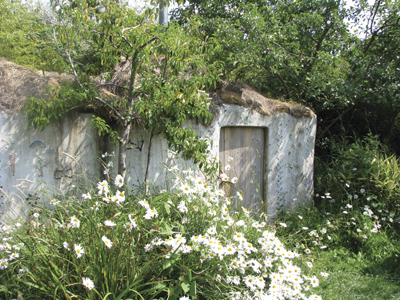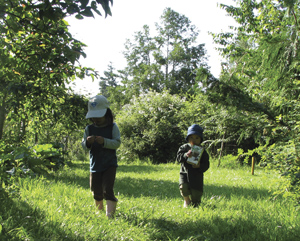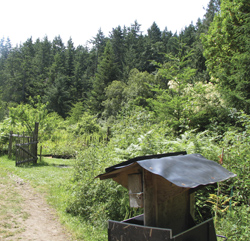Permaculture:
Living and Growing With the Natural World
by Junyee Wang

More and more, individuals are redirecting their lives to change the current destructive direction of our collective human actions. This is never truer than when it comes to having control over the source of our food. Over its history, agriculture has moved us away from our connectedness with Nature. As we reintegrate food as an integral part of our culture, we are turning inwards to ourselves and outwards to our yards, patios, windowsills and community gardens with a revival in growing our own food.
My own first trip to the garden center was mostly spent staring at the seed packets and reading the information printed on them. After purchasing seeds and supplies, I ventured home to start my first growing experiment in our backyard. I did not anticipate the amount of planning, time and care that would be required! Weeds overtook my garden. Insects had their fill. Squirrels made off with my sunflower heads. Broccoli and Brussels sprouts bolted. After that first experience, I decided to take a rest from my grand vision of growing my own food in the garden. However, I continued indoors on my countertop with successfully sprouting mung beans!
Although I didn’t understand it at the time, I had an unsettling feeling about my attempts at growing food and about the mainstream knowledge that is available. The planning, time and care that seem to be necessary was also a force driving me away. What should be a joyful, life-sustaining activity has been turned into one of toil where a chore is never completed with a spirited heart. We have gone down the path towards the creation of genetically modified seeds, decrease in food diversity, dependence on fertilizers and pesticides, overly processed food products and the result of a heavily poisoned environment.
|
Permaculture Principles as listed by David Holmgren
1. Observe and interact
2. Catch and store energy
3. Obtain a yield
4. Apply self regulation and accept feedback
5. Use and value renewable resources and services
6. Produce no waste
7. Design from patterns to details
8. Integrate rather than segregate
9. Use small and slow solutions
10. Use and value diversity
11. Use edges and value the marginal
12. Creatively use and respond to change
Permaculture Principles as listed by Toby Hemenway
1. Observe
2. Connect. Use relative location
3. Catch and store energy and materials
4. Each element performs multiple functions
5. Each function is supported by multiple elements
6. Make the least change for the greatest effect
7. Use small scale, intensive systems
8. Use the edge effect
9. Accelerate succession
10. Use biological and renewable resources
11. Recycle energy
12. Turn problems into solutions
13. Get a yield
14. Abundance is unlimited
15. Mistakes are tools for learning
|
We are immature Buddhas at different stages in our quest to seek the truth about how to create a secure supply of food. As we contemplate our issues with food security, we will find ourselves in different currents of thought: acceptance, depression, anger, repair, and reformation. Some may linger in the acceptance current where the status quo is accepted as fact, either by choice or indifference. Others may go back and forth between anger and depression, wanting desperately to have change but either feeling helpless or finding blame in others. If we’re fortunate, we will have more and more people moving through the repairing-the-system current into a reformation mindset.
Discovering Permaculture
By repairing the system, I am referring to making improvements to the agricultural situation with organic farming, community gardens, community-supported agriculture (CSA), food co-operatives and other means. In terms of reformation, aside from returning to our primeval hunter and gatherer lifestyle, we look to Nature and consider a philosophy known as permaculture.
I stumbled onto this term quite by chance in my university years when I was researching a paper on agriculture’s contribution of greenhouse gas emissions. It didn’t keep my attention at the time because I was living in a condominium and had yet to understand the importance of growing food as a solution to environmental and social problems. Later, as a gardening novice, I found an overwhelming amount of information on gardening: what to plant, how to plant, pest control, organic farming, etc. Luckily, on a library visit, Food Not Lawns by Heather Flores beckoned me to borrow and devour it. It took a long time for me to reconcile with the thought of revealing ourselves instead of hiding behind suburban conformity of a lawn full of grass or a small front garden of ornamentals. Once I moved past that point, I was determined to turn our sunny front yard into a lush food growing oasis. However, unlike the backyard, I decided a plan of some sort was needed.
The next few trips to the library brought back numerous books on edible landscaping. Further research on the internet re-introduced me to permaculture and I purchased Toby Hemenway’s Gaia Garden. The more I looked into permaculture the more I realized how important its concepts are to human survival.
Australians Bill Mollison – a researcher, scientist and naturalist –and ecologist David Holmgren first coined the term in the 1970s by combining the words “permanent” and “culture.” What originally started as an alternative to agriculture quickly became a philosophy of living within the natural world, focusing on opportunities instead of problems.
Bill Mollision is one of the special pioneers who have observed nature’s cycles and movements to recreating an ecosystem that provides food and wild craft materials. His frequent walks through tropical rainforests and other wooded areas gave him an understanding of the intricacies of a forest ecosystem. He observed tropical climates that allowed these complex ecosystems to be created in relatively short time spans. These ecosystems fed the people without much human interference. With Holmgren, he was able to synthesize his knowledge into a design theory which drew disciples from all over the world. Arid deserts in the United States and in the Middle East became oases as determined individuals observed and applied permaculture principles. There is continual research into how permaculture can be implemented in temperate climates as more people are using the principles to design specifically for their site locations.
Permaculture uses system thinking and design principles to equip an individual, groups or communities to design their environment in a way that allows them to live harmoniously with Nature towards a sustainable future. Imagine every adult and child living using permaculture’s three core ethics to drive all their thoughts and actions:
|
Mimicking
the Structure of Nature
Permaculture is notoriously difficult to describe concisely. It is a system of designing human settlements and food growing that mimic the interrelationship found in natural ecologies and is based on the idea that agriculture is inherently unsustainable. It fosters a polyculture using a forest layering effect with as many diverse plants as possible and plant selection and placement based on microclimates. Plants are interplanted everywhere and allowed to set seed. Machinery is used only where necessary. Tilling is not required, as no-dig gardening is usually employed to decrease weed seeds from germinating. Weeds may be left in place, as they could be beneficial and/or edible. All animals and insects are considered beneficial. Water is captured and stored in the soil and in ponds and swales. Compost is not a separate function – kitchen scraps can be buried in the soil and plant material left to decompose. The intersection of two environments, which is called “the edge,” is valued as the most diverse and energetic place in the system, and thus important. |
1. Care for the Earth – Diverse and intact ecosystems are the keys to life. Our sustainability is dependant on the soil we stand on, the air we breathe and the water we drink. Everything living and non-living requires respect.
2. Care for the People – Change starts within ourselves in ensuring self-reliance and personal responsibility. Our circle then expands to include companionship and collaborative effort from our family and friends to the local and wider community.
3. Fair Share – With the inequalities in the world as a reminder, we take only what we need and share what we don’t.
Permaculture zones are a way of organizing design elements based on the frequency of human use. Frequently manipulated or harvested elements of the design are located close to the house in zones one and two, while less frequently manipulated elements are farther away.
Within those zones, groups of plants that benefit each other are called “guilds.” A well-known example of this is the Three Sisters guild of maize/ corn, squash and beans. The beans climb up on the corn stalks, while the squash acts as a ground cover and shades the soil. There are far more complicated permaculture guilds that employ ten or more plants in a seven layer layout. As guilds are created side by side, one can create diverse and enabling polyculture ecosystems where every tree, shrub, perennial and self-seeding annual serves a purpose and supports each other. If this is done at every potential site, we have a powerful solution to a number of our problems.
Toby Hemenway envisions all residential, public and commercial land in the cities as potential permaculture sites. When we start creating a food producing ecosystem close to where it is consumed, we are truly creating a local sustainable system. The need for large industrial farms is greatly reduced. Small local farms can support local economies. Much of the industrial farmland can return to its natural state and provide shelter and food for animals and birds. While we live in urban (suburban, village, town or rural) forest gardens, woodlands will reappear and be left to become old growth forests.
Finding Examples
John Lennon’s song Imagine is one of my favorites. Every time I hear it, I have grand visions of how the world can be. Permaculture represents for me a philosophy and a method for us to make a paradigm shift. Imagine roads and driveways that harvest and store rain water. Imagine Nature all around us and food growing everywhere. Imagine harmony with the natural world. Unfortunately, imagining is too theoretical for some of us, so I have been seeking practical examples.
While my family and I were in Vancouver, B.C. last summer, we visited the Bullock Permaculture Homestead on Orcas Island in nearby Washington State. The island sits in the rain shield, which gives it a more moderate and less wet climate. On the 10 acres the Bullocks own and the eight acres they lease, the topography of the site includes a marsh, ponds, a rock escarpment and some low lying areas, all of which contribute to a remarkable assortment of microclimates. The location is perfect for some of the amazing sub-tropical and temperate plants and trees that they are growing.
We arrived in the evening and were greeted with smiling faces and pizza from the cob oven. Interns and visitors routinely gather in the outdoor kitchen and classroom to dine and dialogue with each other. This common area is a natural connection to the land where the food was grown. There is a simple gray water system consisting of a sink drain leading to a bucket of straw to catch grease and debris. The water then flows to another straw filtering basin, then into a garden bed. Eventually the water makes its way to the pond at the bottom of the slope. That cob oven and outdoor sink/gray water system is now firmly etched in my mind as projects I want to tackle next summer!

The author’s two daughters wander through a permaculture garden, absorbing, along with their parents, the wisdom of the self-sustaining system.
Photo © Junyee Wang |
Waking up to the first morning calls of the roosters was something I was looking forward to. Lying awake in our tent anticipating when that was going to happen had become a waiting game. When the alpha rooster started to call out, all the other roosters began to follow. I had only seen one area where a rooster and several hens were kept. Listening to the calls and callbacks, I realized that there were three separate groups. I rose to the roosters’ welcome and began to explore what many consider to be one of the best examples of permaculture homesteads in the Pacific Northwest.
My husband Gary, the girls, and I spent most of our time walking, observing, helping and talking to the Bullocks and the interns. It was a casual and blissful existence, indeed. As short a visit as it was, I absorbed the energy and excitement that breathed through everyone who was there. I opened up my eyes and ears to an assortment of wisdom and knowledge coming our way from Sam and Doug Bullock, Dave Bohnlein, the interns and the other visitors to the homestead.
Mature fruit trees were surrounded by soil-enriching plants such as comfrey. I learned how to cut the comfrey with a scythe and to create a donut basin around the foot of the tree. The idea was to have the basin catch and hold water long enough to allow for deep penetration to the tree roots. As the comfrey decomposes, the leaves release the high amount of nutrients accumulated. The trees serve as the canopy to an assortment of plants. All together, these comprise an example of a guild, with each plant serving a purpose. Comfrey is fertilizer. Calendula and other flowers attract pollinators. In between the spacing of the trees are larger garden patches of perennial plants and annual vegetables that require more sunlight.
Water moves through the site from the marsh underground to various ponds on its way to the sound where it meets the sea water. In order to maintain the fresh water as long as possible, a solar-powered pump moves the water from the last pond to irrigate the land. The plan is to carry the water up high to the rocky faces where terraces have been created for a three- tiered pond system. Water would be pumped from the marsh using solar power to the highest pond. Theoretically, the water will allow for further plant growth on the rocky outcrops while it travels downward to the lower ponds and eventually returns to the marsh.

Photo © Junyee Wang |
I became overly excited about something called chinampas. Chinampas is a traditional Mexican method of building up an island in marshy areas or shallow lakes. Debris and dirt are piled over long branches to create platforms on which crops can be grown. Willow trees can be used to anchor the corners of the islands. Historically, corn, being the staple crop, can be sown directly onto the chinampas. Other plants could be transplanted over as nursery seedlings. I plan to build some chinampas to create peninsulas on our rural land, as the low lying area where our creek runs through is quite wide.
Our daughters Brooklyn and Kaitlyn quickly made friends with Doug and Maria Bullocks’ children, Nya and Kajetan. In addition to learning about the site and some interesting techniques, I was lucky enough to witness a true unschooling environment. Kajetan had spent part of his summer learning circus skills and building his own kayak. Nya often goes exploring with her brother. Whenever they fancy it, they take the canoe out into the marsh. Brooklyn and Kaitlyn both became pole climbers after witnessing Nya and Kajetan climb. And they became nectar suckers when introduced to the sweet liquid found in the yellow flowers.
One of the most freeing aspects of our trip was the fact that our human waste was never considered waste. Urinate could be deposited everywhere except on the lettuces and other greens. Our solid wastes were collected and composted. Nothing is considered waste or thrown away. Everything has multiple purposes – even that which we would normally consider waste in our everyday lives.
As a working and learning weekend trip, visiting the Bullock Homestead was a great way for us to visualize our own plans. Our urban front lawn is now fast becoming a haven for crickets, butterflies, bees and birds. Last summer’s gardening venture proved rather more successful than my first attempts. We harvested mint, basil and daikon, although the snails and rabbits consumed all our greens. In the fall, garlic, potatoes and onions matured. The soil was improved with cover crops of alfalfa, clover and buckwheat. Next year, more perennials will find a home in the garden as we implement more permaculture ideas. The accumulation of knowledge and experience will serve us well, as the task of designing the layout of our rural land will prove to be challenging and intriguing at the same time. My black thumb is turning into a nice shade of yellow.
Learn More
Food Not Lawns: How to Turn Your Yard into a Garden And Your Neighborhood into a Community by Heather Coburn Flores (Chelsea Green, 2006)
Permaculture: Principles and Pathways Beyond Sustainability by David Holmgren (Holmgren Design Services, 2002)
Gaia’s Garden: A Guide to Home-Scale Permaculture by Toby Hemenway (Chelsea Green, 2001)
Permaculture: A Designers’ Manual by Bill Mollison (Tagari Publications, 1997)
The Permaculture Garden by Graham Bell (Permanent Publications, 2005)
Edible Forest Gardens by Dave Jacke (Chelsea Green, 2005)
How to Make a Forest Garden by Patrick Whitefield (Permanent Publications, 2002)
The One Straw Revolution by Masanobu Fukuoka (Rodale Press, 1978)
Junyee Wang is the mother of two young and spirited daughters. When she wrote this article in 2009, she was completing a Masters of Environmental Studies and continuing her interest in permaculture, philosophy and story-telling. Junyee plans on returning to the Bullock Brothers Homestead for a longer stay to complete a permaculture design course.
|

